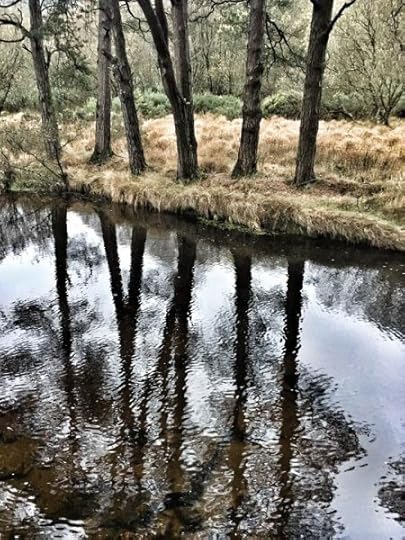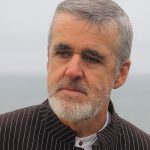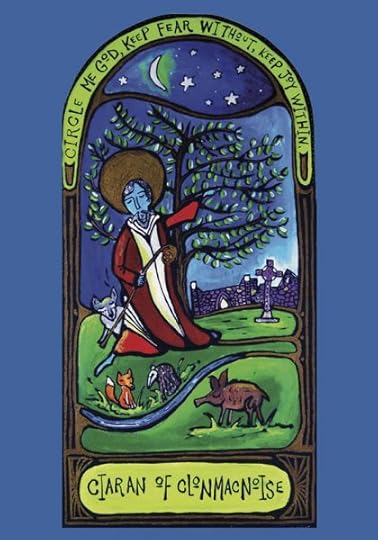Christine Valters Paintner's Blog, page 89
September 22, 2018
Celebrating Autumn’s Harvest and Release ~ A Love Note from Your Online Abbess
 Song for the Salmon (excerpt)
Song for the Salmon (excerpt)
For too many nights now I have not imagined the salmon
threading the dark streams of reflected stars,
nor have I dreamt of his longing
nor the lithe swing of his tail toward dawn . . .
I am ready like the young salmon
to leave his river, blessed with hunger
for a great journey on the drawing tide.
—David Whyte
Dearest monks, artists, and pilgrims,
The autumn equinox falls today in the northern hemisphere (click here if you are in the southern hemisphere welcoming spring)—a time when the sun rests above the equator, and day and night are divided equally. It heralds a season filled with change, celebrates the harvest, and ushers in the brilliant beauty of death. Autumn is a season of transition, of continual movement.
At the heart of autumn's gifts are these twin energies of relinquishing and harvesting. It is a season of paradox that invites us to consider what we are called to release and surrender, and at the same time it invites us to gather in the harvest, to name and celebrate the fruits of the seeds we planted months ago. In holding these two in tension we are reminded that in our letting go we also find abundance.
In the seas of the Northwest U.S. where I used to live, the salmon are responding to an ancient and ancestral call. They are returning from the oceans, and making the hard and often battering journey up the rivers, to return to their birthplaces to lay eggs offering the gift of new life. This journey always ends in their own death. It is an amazing mystery as I imagine this deep longing for home the salmon must feel and the ultimate surrender they welcome while also offering a harvest of blessing for the next generation of salmon.
I have love the beauty of autumn leaves releasing their hold. I have walked close to death many times in my life now, journeying with my own mother the last few days of her life in the ICU after a massive infection ravaged her body, then with John’s mother who let go after a very long journey with Alzheimer's and the great unravelling it causes. Fall thrusts us into the messiness of life and challenges us not to turn away. The season of autumn calls me to honor the full spectrum of human experience, to not push away the sorrow and grief, to not fill the waiting with distractions. I rest into the unknown, I stay present to the great sadness I sometimes feel.
As I walk each day, fall offers solace with her unbearable beauty. But some days, the wind gusts through and the trees are stripped bare. I weep at the ache I feel when I consider how everything I love in this world will one day die. The season calls me to let go of false assumptions, wrests my too-small images of God from me as I enter the Mystery of dying and rising. Autumn demands that I release what I think is important to do and returns me to the only thing which matters that I remember—to love and to allow love to sculpt me, even as it breaks my heart.
But equally, this season calls us to the harvest. Seeds planted long ago create a bounty and fullness in our lives. Autumn invites me to remember the places in my life where I had a dream that once felt tiny and has now grown and ripened into fullness. I savor these places where my life feels abundant. I relish the experience of being nourished by dreams into my own growing wholeness.
The poet Rilke writes of autumn: "Command the last fruits to be full; / give them just two more southern days, / urge them on to completion and chase / the last sweetness into the heavy wine." We move toward our own ripening and in that journey we let go of what no longer serves us. Fall urges us on to our own completion and sweetness.
We live in times when it often feels like everything is coming undone. This season reminds us that the journey of relinquishing all we hold dear is also the journey of harvesting. Somehow these two come together year after year. We are invited to rest into its mystery.
What are you releasing that no longer energizes you?
What dreams do you want to harvest this season?
With great and growing love,
Christine
Christine Valters Paintner, PhD, REACE
Photo © Christine Valters Paintner
September 18, 2018
Monk in the World Guest Post: Michelle Lisenbee
I am delighted to share another beautiful submission to the Monk in the World Guest Post series from the community. Read on for Michelle Lisenbee's reflection on caring for chickens as spiritual practice.
I live in the Mid-Atlantic. Our summers tend to be very warm and very humid. Not like, jungle humid, but sometimes it feels pretty darn close. One Sunday morning, in late July of 2017, I opened the door to feel blessed coolness. It had been in the high nineties all week. This morning, it was only in the seventies and the usual humidity was absent. I knew it would be back, but for this morning, it was glorious. The sun was shining, the sky was a perfect blue and a light breeze ruffled the leaves of the trees that ringed our back yard. I stepped barefoot out the door, off the porch and into the dewy grass, savoring the cool feel of it on my feet. Our chocolate Labrador, Shasta, always within touching distance of me, followed me out. While she snuffled about and did her business, I slowly crossed the yard to let our chickens out for the day.
We have a small mobile coop and five hens we adopted from a friend when she moved out of state and couldn’t take them with her. We’d gotten only them six weeks earlier and I was still learning how to be a chicken mom. As I approached, I heard them softly clucking to each other. As they heard me coming, they got louder, greeting me in their chicken-y way. I smiled and knelt to open their little doorway. One by one, they hopped down into the grass and began pecking and scratching, looking at me sideways to see if I had something good for them to eat. I reached out to stroke each of them in turn and sang them the silly little “good morning song” I’d made up. Once they realized I had no treats, they ignored me. I placed their ladder, checked their food and water and latched the door. I turned and opened the nesting box lid to check for eggs – and found one perfect brown oval there resting on the sweet-smelling pine shavings. I cupped it in my palm. It felt perfect – round and smooth and warm.
I held it gently as I continued to wander through the lush greenness in our small corner of the world. My attention was captured by a blaze of yellow at our woodpile. I had seen these volunteer flowers growing there earlier and had warned my husband and sons not to mow them down. Today, they were in full, riotous sunshine-y bloom. Coreopsis, I thought. I did not plant them here. I had planted others in the front yard, but none in the back. I had no idea how they ended up here, but they did. The juxtaposition of the messy, overgrown woodpile and the bright happy blossoms lit up my heart. In that moment, I felt completely full of overwhelming gratitude for all of it: the gorgeous weather, the early morning egg, the blooming woodpile. I stood quietly, surrounded by God’s creation – earth, sky, plants, and animals and breathed it in. I felt myself a part of it. As I gave thanks for everything, I realized I need to include myself as part of the picture. As God created all that surrounded me, he also created me. And just as each blade of grass and each perfect egg was a unique creation, made only once, so was I. My eyes welled up. This, I thought. This is truth.
It’s now been a year since we adopted our chickens. Stepping outside twice a day to care for them has become one of my primary spiritual practices. I know, it probably seems odd to call caring for chickens a spiritual activity, but for me, it is. Every single day that I am home, at dawn and just after dusk, I step outside, barefoot if the weather allows. I pause. I breathe. I look up. I check for eggs. I supply food, water and as much safety as I can. I give thanks.
Being outside at the opening and closing of each day helps keep me in in touch with what is real. I notice the weather. I notice the position of the sun. I notice the phase of the moon. I notice the fireflies. (Oh the magical wonder of fireflies in summer!!) I notice the melting snow, the parts of our yard that stay wet for days after a rain, the birds that have built nests in our shed eaves, the bunnies that hop softly about. I hear woodpeckers in the dead tree next door, the geese that migrate overhead, the squirrels that race around playing tag.
Watching the seasons unfold and flow one into the next is part of what it means to be a monk in the world for me. Every dawn reminds me that we have the chance to begin again. Every dusk reminds me to give thanks for the blessings of the day. As a nurse and massage therapist, remembering that we are all part of God’s amazing creation brings more compassion to my work. And as an artist, gratitude and nature often make their way onto my canvases. Even if the whole wide middle of my day ends up feeling out-of-sorts, these bookend moments are (usually!) enough to bring me back to center. Praying we all find centering moments in our day – with or without chickens. Blessings.
 Michelle Lisenbee is a Registered Nurse, massage therapist and artist. She lives in a 100 year old house in the Maryland suburbs with her husband, two teenage sons, a large dog, three cats and of course, chickens. You can find her at www.michellelisenbee.com or on Facebook at https://www.facebook.com/MichelleLisenbeeArt/
Michelle Lisenbee is a Registered Nurse, massage therapist and artist. She lives in a 100 year old house in the Maryland suburbs with her husband, two teenage sons, a large dog, three cats and of course, chickens. You can find her at www.michellelisenbee.com or on Facebook at https://www.facebook.com/MichelleLisenbeeArt/
September 16, 2018
Celtic Conversations with Dara Molloy
 I am delighted to introduce a new podcast series, Celtic Conversations, inspired by my new book The Soul's Slow Ripening: 12 Celtic Practices for Seeking the Sacred and my time living in Ireland. I am hosting a series of conversations with authors, artists, and guides about Celtic spirituality. So find a cozy space and pour yourself a cup of tea. (Also available at Soundcloud, Stitcher and iTunes).
I am delighted to introduce a new podcast series, Celtic Conversations, inspired by my new book The Soul's Slow Ripening: 12 Celtic Practices for Seeking the Sacred and my time living in Ireland. I am hosting a series of conversations with authors, artists, and guides about Celtic spirituality. So find a cozy space and pour yourself a cup of tea. (Also available at Soundcloud, Stitcher and iTunes).
My guest today is Dara Molloy and we had a delightful conversation about seasonal connections, living in the wilderness, Celtic rituals, living continuously in a sense of divine presence, and the Irish tradition as a mentor, and mysticism of the Celtic tradition.

 Dara Molloy is a Celtic monk, priest and druid. He began his adult life as a Roman Catholic priest ordained into The Society of Mary (Marists). In 1985 he moved to the Aran Islands to live as a Celtic hermit. He lived in a small wooden garden shed for 10 years. During this time his work developed into offering hospitality to wanderers and seekers in a thatched cottage next to his hut. In 1995, Dara formally left the Catholic Church. He declared that he was remaining a priest and began to offer spiritual services such as weddings, christenings (naming ceremonies), rites of passage and funerals inspired by the Celtic tradition. He offered these from the standpoint of not belonging to any church, sect or cult. This is now his full-time work apart from some writing and leading of pilgrim groups. Dara is married to Tess Harper and they have four children. He is the author of two books: Legends In The Landscape A Pocket Guide to the spiritual sites of Inis Mor, Aran Islands and The Globalisation of God – Celtic Christianity’s Nemesis. He has a new book to be published in the coming year provisionally entitled Rethinking God – A Celtic Perspective. You can find out more about him at his website.
Dara Molloy is a Celtic monk, priest and druid. He began his adult life as a Roman Catholic priest ordained into The Society of Mary (Marists). In 1985 he moved to the Aran Islands to live as a Celtic hermit. He lived in a small wooden garden shed for 10 years. During this time his work developed into offering hospitality to wanderers and seekers in a thatched cottage next to his hut. In 1995, Dara formally left the Catholic Church. He declared that he was remaining a priest and began to offer spiritual services such as weddings, christenings (naming ceremonies), rites of passage and funerals inspired by the Celtic tradition. He offered these from the standpoint of not belonging to any church, sect or cult. This is now his full-time work apart from some writing and leading of pilgrim groups. Dara is married to Tess Harper and they have four children. He is the author of two books: Legends In The Landscape A Pocket Guide to the spiritual sites of Inis Mor, Aran Islands and The Globalisation of God – Celtic Christianity’s Nemesis. He has a new book to be published in the coming year provisionally entitled Rethinking God – A Celtic Perspective. You can find out more about him at his website.

Dara Molloy shared two beautiful poems with us to begin our time together:
The Wish of Manchán of Liath
(A 10th century poem, anonymous, about the dream of a 6th century monk)
I wish, O son of the Living God, ancient eternal King, for a secret hut in the wilderness that it may be my dwelling.
A very blue shallow well to be beside it, a clear pool for washing away sins through the grace of the Holy Ghost.
A beautiful wood close by around it on every side, for the nurture of many-voiced birds, to shelter and hide it.
Facing the south for warmth, a little stream across its enclosure, a choice ground with abundant bounties which would be good for every plant.
A few sage disciples — I will tell their number — humble and obedient, to pray to the King.
Four threes, three fours, ready for every need, two sixes in the church, both south and north.
Six couples in addition to me myself, praying through the long ages to the King who moves the sun.
A lovely church decked with linen, a dwelling for God of Heaven; then, bright candles over the holy white Scriptures.
One room to go to for the care of the body, without ribaldry, without boasting, without meditation of evil.
This is the housekeeping I would get. I would choose it without concealing. Fragrant fresh leeks, hens, salmon, trout, bees.
My fill of clothing and of food from the King of good fame, and for me to be sitting for a while praying to God in every place.
The Lake Isle of Innisfree — W.B. Yeats, 1865 – 1939
I will arise and go now, and go to Innisfree,
And a small cabin build there, of clay and wattles made:
Nine bean-rows will I have there, a hive for the honey-bee;
And live alone in the bee-loud glade.
And I shall have some peace there, for peace comes dropping slow,
Dropping from the veils of the morning to where the cricket sings;
There midnight’s all a glimmer, and noon a purple glow,
And evening full of the linnet’s wings.
I will arise and go now, for always night and day
I hear lake water lapping with low sounds by the shore;
While I stand on the roadway, or on the pavements grey,
I hear it in the deep heart’s core.
*Opening music track is an excerpt from Simon DeVoil's song "Water" on his album Heart Medicine (used with kind permission)
September 15, 2018
Feast of St. Hildegard of Bingen ~ A love note from your online abbess
 St. Hildegard Strolls through the Garden
St. Hildegard Strolls through the Garden
Luminous morning, Hildegard gazes at
the array of blooms, holding in her heart
the young boy with a mysterious rash, the woman
reaching menopause, the newly minted widower,
and the black Abbey cat with digestive issues who wandered
in one night and stayed. New complaints arrive each day.
She gathers bunches of dandelions, their yellow
profusion a welcome sight in the monastery garden,
red clover, nettle, fennel, sprigs of parsley to boil later in wine.
She glances to make sure none of her sisters are
peering around pillars, slips off her worn leather shoes
to relish the freshness between her toes,
face upturned to the rising sun, she sings lucida materia,
matrix of light, words to the Virgin, makes a mental
note to return to the scriptorium to write that image down.
When the church bells ring for Lauds, she hesitates just a
moment, knowing her morning praise has already begun,
wanting to linger in this space where the dew still clings.
At the end of her life, she met with a terrible obstinacy,
from the hierarchy came a ban on receiving
bread and wine and her cherished singing.
She now clips a single rose, medicine for a broken heart,
which she will sip slowly in tea, along with her favorite spelt
biscuits, and offer some to the widower
grieving for his own lost beloved,
they smile together softly at this act of holy communion
and the music rising among blades of grass.
— Christine Valters Paintner
Dearest monks, artists, and pilgrims,
September 17th is the Feast of Holy Hildegard, one of the patron saints of our work here in Abbey because of her roots as a Benedictine monk and Abbess, and her incredible commitment to creative expression and nurturing aliveness. I am currently in the Rhine valley in Germany co-guiding a group of pilgrims here to walk in her footsteps.
I am the living breath in a human being placed in a tabernacle of marrow, veins, bones, and flesh, giving it vitality and supporting its every movement.
—St. Hildegard of Bingen, Scivias I 4:4
Hildegard of Bingen was a 12th century Benedictine Abbess, who was also a theologian, visionary, musical composer, spiritual director, preacher, and healer. For centuries monasteries have been centers of healing and herbal medicine. Monks would grow the herbs and learn their applications, so that people would come for both spiritual and physical healing.
We have lost this connection, with medicine taking place in the efficient and sterile halls of hospitals. Please don’t misunderstand me, I am profoundly grateful for the gifts of modern medicine, and rely on it to some degree to maintain my own quality of life. And yet, we have lost so much in this shift from the model of slow medicine and healing to the pursuit of quick cures. In the process we have come to compartmentalize ourselves, seeking the fix for the headache or the stomach trouble, without considering the whole of our bodies and our lives. We become impatient when illness descends, rather than yielding to body’s needs and desires.
We rarely have a relationship with our doctors, spending only minutes with them each visit, whereas Hildegard, and other monastics like her, would have come to know her patients. She would have seen the profound connection between body and soul. She would have practiced slow medicine.
One of the fundamental principles of Hildegard’s worldview is viriditas, which means the “greening power of God.” But even more than that, it refers to a lushness and fecundity in the world, a greening life force we can witness in forests and gardens and farmland. Hildegard, who lived in the valley around the river Rhine in Germany, was profoundly impacted by her witness to the profusion of greenness and how this green life energy was a sign of abundance and life. It is what sustains and animates us.
Greenness became not just a physical reality, but a spiritual one as well. Hildegard believed that viriditas was something to be cultivated in both body and soul. Her language is filled with metaphors for seeking out the moistness and fruitfulness of the soul. The sign of our aliveness is this participation in the life force of the Creator. Anything that blocks this flow through us contributes both to physical disease as well as spiritual unrest.
For Hildegard, viriditas was always experienced in tension with ariditas, which is the opposite experience of dryness, barrenness, shriveling up. She would keep asking how to bring the flow of greening life energy back in fullness to a person.
Victoria Sweet, a medical doctor in San Francisco and researcher in medieval history, wrote a wonderful book called God’s Hotel: A Doctor, a Hospital, and a Pilgrimage to the Heart of Medicine in which she explored Hildegard’s principles of greening in her own medical practice. Dr. Sweet worked in a long-term care facility and began to ask the question of what was blocking a patient’s access to this life-giving greening energy and shifting her perspective enabled her to find healing paths that were previously unseen. She also discovered that simply being in relationship with her patients over time allowed her to see patterns and behaviors which revealed far more into their care than a quick visit could ever do.
There is a story from the desert fathers where an Abba says to a seeker, “Do not feed your heart what does not nourish it.” This can be easier said than done, since we are inclined to so many “comforts” which only serve to numb and distract us from life. How often do we try to satisfy ourselves with that which depletes us?
What if your fundamental commitment was to only offer your body and soul that which is nourishing and to listen to what depletes you and say no to those things.
I invite you to hold this question in all things: Does this nourish me or does this deplete me?
(We have a self-study online retreat to dive more deeply into the wisdom of Hildegard of Bingen and we hope to lead our next pilgrimage to Germany in 2021.)
With great and growing love,
Christine
Christine Valters Paintner, PhD, REACE
Dancing monk icon by Marcy Hall at Rabbit Room Arts
September 11, 2018
Monk in the World Guest Post: Elaine Breckenridge
I am delighted to share another beautiful submission to the Monk in the World guest post series from the community. Read on for Elaine Breckenridge's reflection on artistic wounds.
I like the idea of the expressive arts, as long as it doesn’t mean using my hands to create in conventional ways. Give me a pencil to draw, or a brush to paint, even a magazine and a glue stick and I freeze. Over the years at conferences when I see the arts and crafts table set up for the “right brain activity,” something inside of me dies again. I have been known to rebel by sitting on the floor underneath the table writing a poem instead.
I credit my first-grade teacher for helping me to develop this resistance. One day she required me to stay after school with the assignment of cutting beautiful snowflakes like everyone else in the class. I failed. I am left handed. Using righthand scissors there was no way snowflakes were going to happen. Only hot tears of shame and humiliation fell that day. I’ve never tried to make a snowflake since that day.
Being a student of the Abbey of the Arts has had its challenges for me since there are many invitations to make art. While the atmosphere around the expressive arts projects on a pilgrimage to Ireland with Christine and John was inviting and non-judgmental; I still felt very self-conscious. My St. Bridget’s cross, my candle, my painted rock in my mind were inferior to everyone else’s. I thought it would be “good for me” to try to make a mandala every day, so I signed up for the Hildegard of Bingen on-line retreat. I quietly faded away, unable to complete the assignments because of my wounds. I wanted to take the “Artist’s Rule” on-line class, to explore writing and creativity in general, but I just could not muster the courage and confidence to do so.
That said, I believe in my very being that I am artistic. As an Episcopal priest, my creativity and artistry can be seen in the way I craft traditional services as well as innovative rituals. I have a knack for bringing together words, music, and liturgical art in ways that are meaningful for people. My preaching can be creative as well as my teaching.
But what I do does not last. Liturgy is like building a gorgeous sandcastle on a beach. We admire it. It gives us joy in a brief window of time. But all too soon, the tide rises and sweeps it away. The liturgy ends and we go our separate ways. The tangible experience slips into the ether. Is it ego that would like to make something with my hands that would be a more concrete expression of what I can do and offer God’s world? I don’t think so. I think I have a genuine desire to give birth to something that can be held and cherished.
And so, I tried again. I went to a bead making workshop. The teacher was very gentle as were the people at my table. And look what I made–a mini rosary. I cherish holding it and the process has been very healing.
What I know is that I still carry the wounded child who needs to be both encouraged and protected. But digging deeper, I have come to realize that my wounds are a source of perverse pride. Clinging to this false narrative that I can’t use my hands to make art has given me permission to take few risks. And it has cut me off from the wonder of exploration.
Because I want to continue practicing expansiveness in all aspects of my life and not contraction, I am going to give myself permission to keep experimenting with other mediums. And I will still claim my right to make art in the way I am called. Perhaps most importantly, I am going to try to be more conscious. Am I choosing my artistic medium out of love or rebelling out of fear?
Ironically, my first-grade teacher’s name was Miss Tombs. She has haunted me long enough. It’s time to let her go. Someday I will draw a picture of her, maybe even standing beside a tomb. But for today, look what I just made. Let it snow!
 Elaine Breckenridge is a dancing monk and an Episcopal priest currently serving St. John the Baptist Church in Lodi, California. Her passions include incorporating Celtic and Creation Spirituality into traditional liturgical forms, the music of Kristopher E. Lindquist (Kelmusic.com), yoga and living the Abbey of the Arts Monk Manifesto.
Elaine Breckenridge is a dancing monk and an Episcopal priest currently serving St. John the Baptist Church in Lodi, California. Her passions include incorporating Celtic and Creation Spirituality into traditional liturgical forms, the music of Kristopher E. Lindquist (Kelmusic.com), yoga and living the Abbey of the Arts Monk Manifesto.
September 9, 2018
Celtic Conversations with Christine Sine
 I am delighted to introduce a new podcast series, Celtic Conversations, inspired by my new book The Soul's Slow Ripening: 12 Celtic Practices for Seeking the Sacred and my time living in Ireland. I am hosting a series of conversations with authors, artists, and guides about Celtic spirituality. So find a cozy space and pour yourself a cup of tea. (Also available at Soundcloud, Stitcher and iTunes).
I am delighted to introduce a new podcast series, Celtic Conversations, inspired by my new book The Soul's Slow Ripening: 12 Celtic Practices for Seeking the Sacred and my time living in Ireland. I am hosting a series of conversations with authors, artists, and guides about Celtic spirituality. So find a cozy space and pour yourself a cup of tea. (Also available at Soundcloud, Stitcher and iTunes).
My guest today is Christine Sine and we had a delightful conversation about Celtic spirituality and the act of blessing, the love of creation, the two books of revelation, and cultivating awe and wonder in our lives.

 Christine Sine is the founder and facilitator for the popular contemplative blog Godspace, which grew out of her passion for creative spirituality, gardening and sustainability. She describes herself as a contemplative activist, passionate gardener, author, and liturgist. She loves messing with church traditions and inspiring followers of Jesus to develop creative approaches to spirituality that intertwine the sacred through all of life.
Christine Sine is the founder and facilitator for the popular contemplative blog Godspace, which grew out of her passion for creative spirituality, gardening and sustainability. She describes herself as a contemplative activist, passionate gardener, author, and liturgist. She loves messing with church traditions and inspiring followers of Jesus to develop creative approaches to spirituality that intertwine the sacred through all of life.
Christine facilitates workshops on contemplative and creative spiritual practices, spirituality and gardening, simplicity and sustainability as well as how to develop a more spiritual rhythm for our lives. She often encourages participants to paint rocks or leaves, plant contemplative gardens, walk labyrinths and create spiritual pathways that draw us into deeper intimacy with God. Christine is inspired by Celtic Christian spirituality, which has opened her eyes to the God who is present in every moment, every experience and every place.
Her new book, due to be published in March 2019 by InterVarsity Press is The Gift of Wonder:Creative Practices For Delighting in God. Her other books include Rest in the Moment: Reflections for Godly Pauses, Return to Our Senses: Reimagining How We Pray, To Garden with God, Light for the Journey, GodSpace: Time for Peace in the Rhythms of Life, and Tales of a Seasick Doctor. Christine and Tom Sine also co-authored Living on Purpose: Finding God’s Best for Your Life.
You can connect to her on her website, Twitter, Facebook, Instagram, Pinterest, and YouTube.

Christine Sine shared this beautiful blessing she wrote to begin our time together:
*Opening music track is an excerpt from Simon DeVoil's song "Water" on his album Heart Medicine (used with kind permission)
September 8, 2018
Feast of St. Ciaran ~ A love note from your online abbess
 Dearest monks, artists, and pilgrims,
Dearest monks, artists, and pilgrims,
September 9th is the Feast of Ciaran of Clonmacnoise, one of the great Irish saints. He lived in the 6th century and is one of the great monastic founders called the “Twelve Apostles of Ireland.” Ciaran had a kinship with animals. There are stories of him befriending a fox who would carry his Psalter back and forth to his teacher so he could learn. He had a cow which gave milk to all of the Abbey. The cow was so revered that when she died, her hide became a kind of relic and it was said to offer healing, and whoever laid on it would go to heaven. Ciaran would also put his books on the antlers of a stag, as a kind of book rest. It was also said that a boar became his first monk.
There is a story that Ciaran goes out to the island of Inismor to visit with the great Abbott Enda. There they both have a dream of great fruitful trees growing beside a stream in the middle of Ireland. In the vision they could see the tree protecting the entire island with abundant fruit provided.
Enda told Ciaran: "The great tree is you, Ciaran, for you are great in the eyes of God and all people. All of Ireland will be sheltered by the grace in you, and many will be nourished by your fasting and prayers. Go to the center of Ireland, and found your church on the banks of a stream."
I love this great and flourishing tree as symbol of Ciaran’s call in life. He was moving toward his own soul’s ripening. The dream pointed the way.
He founded his monastery at the intersection of the river Shannon running north to south, and the esker, a system of ridges forming a natural roadway, which runs across Ireland from east to west. Clonmacnoise became one of the largest and most significant monasteries of the entire Irish church as a center of learning.
What dreams are calling to you as summer begins to turn to autumn (or winter into spring if you are in the southern hemisphere)?
With great and growing love,
Christine
Christine Valters Paintner, PhD, REACE
Dancing monk icon by Marcy Hall at Rabbit Room Arts
September 4, 2018
Monk in the World Guest Post: Mary Davis
I am delighted to share another beautiful submission to the Monk in the World guest post series from the community. Read on for Mary Davis' reflection, Creating a Tech Sabbath: Uninterrupted Being.
In unscheduled moments, my soul speaks and my heart listens.
Sundays are heavenly in my little “monastery” by the sea. This is my day to linger longer in morning meditation. A day when I can stretch, breathe and align without a phone chirping on the corner of my yoga mat. This is the day when my gratitude practice is not confined to a specific time of morning, but becomes a joyful journey of finding the holy in the small and the sacred in everyday moments. It is a day to read, to contemplate, to welcome and to allow.
For many years I have powered down all electronics on Sundays. It was a little stressful at first, and as the only employee of my inspirational creative arts business, there was no end to the stream of writing, digital art, and the making of cards and prints. Although everything that I write and create is spiritual in nature, it all takes place with my hands on a keyboard and my eyes on a screen. My soul aches for the freedom of looking into the distance, inside and out.
After a few Sundays of practice, I began to relish the open-ended flow of unstructured time to recharge my heart, create with my hands, nourish my soul and answer the call of spirit—without electronic interruption. I call this glorious day my Tech Sabbath.
The word Sabbath originates in the word sabat, meaning to stop or to rest. It is a day of renewal and devotion, honoring God’s rest following six magnificent days of creation. In monastic traditions, Sundays were a day of rest with a focus on meditation, prayer and devotional reading.
I, too, need spiritual renewal after six long days of worldly ways. I need the space to remember the tender truth that most real creation doesn’t take place on the phone. It happens in the heart. The heart deserves untethered time to integrate the lessons of the magnificent co-creation of the week. And so my Sabbath has become a day to honor the sacred spirit, remembering that wisdom and clarity originate in moments of stillness, prayer and listening.
In preparation for the Tech Sabbath, I tidy up my desk on Saturday night and ready myself for a fresh start on Monday morning. The excitement of spiritual freedom builds as I place special cloths over the desktop computer where my art is made and the laptop computer where my writing is done. The guidelines for Sundays are simple: to do nothing on a computer or phone, which includes no email, social media, news, online shopping or work of any kind. For my daughter or a friend in need, it is necessary to glance at texts, but I answer only the essential.
On any given Sunday my time might be completely unscheduled as I float with a steaming cup of Earl Grey to whatever nourishes my spirit. On the next Sunday I might have at the ready a good book, my journal, some cooking or hobby supplies, my kayak, my walking shoes—earthly tools that support my contemplative heart. The phone stays inside for beach walks, gardening and reading on the patio.
After a flurry of doing during the week, it is a retreat for my soul to step off the train of constant connectivity to bask in uninterrupted being. The walls of work that I build around myself for six days swing wide open to divine wisdom. I receive more focus, clarity and intuitive guidance when I step away and open up the channels of Sunday grace each week.
I have come to realize that my Tech Sabbath is one of the best gifts I have given to myself. I am slowly learning how to downshift into holy downtime, into rest and renewal, into lingering and listening, into being and allowing. I had to teach myself to break the endless routine of overworking at the computer and learn how to disconnect to reconnect, how to unplug to get centered, how to step away to come closer.
Creating space for uninterrupted being has become a sacred practice on my journey as a monk in the world.
 Mary Davis is an author, wisdom seeker, spiritual teacher, graphic artist and founder of Every Day Spirit. She has a house by the sea and lives a contemplative life in harmony with nature. Her creative adventures can be found here: www.everydayspirit.net
Mary Davis is an author, wisdom seeker, spiritual teacher, graphic artist and founder of Every Day Spirit. She has a house by the sea and lives a contemplative life in harmony with nature. Her creative adventures can be found here: www.everydayspirit.net
September 3, 2018
Celtic Conversations with Christine Valters Paintner (a new podcast series!)
 I am delighted to introduce a new podcast series, Celtic Conversations, inspired by my new book coming out on September 7th – The Soul's Slow Ripening: 12 Celtic Practices for Seeking the Sacred – and my time living in Ireland. I am hosting a series of conversations with authors, artists, and guides about Celtic spirituality. So find a cozy space and pour yourself a cup of tea.
I am delighted to introduce a new podcast series, Celtic Conversations, inspired by my new book coming out on September 7th – The Soul's Slow Ripening: 12 Celtic Practices for Seeking the Sacred – and my time living in Ireland. I am hosting a series of conversations with authors, artists, and guides about Celtic spirituality. So find a cozy space and pour yourself a cup of tea.
In this first episode in the series, I am launching my book which is officially released this Friday and I share a bit about what inspired the series, some of what I love about the Celtic spiritual tradition, and the story of St. Kevin and the Blackbird, as well as the poem I wrote inspired by this story.
We have 12 episodes prepared for you which will be published each Monday:
Sept 3 – Christine Valters Paintner, The Soul's Slow Ripening: 12 Celtic Practices for Seeking the Sacred
Sept 10 – Christine Sine, Rest in the Moment: Reflections for Godly Pauses
Sept 17 – Dara Molloy, The Globalisation of God: Celtic Christianity's Nemesis and Legends in the Landscape
Sept 24 – Mary Earle, author of Holy Companions: Spiritual Practices with the Celtic Saints and Celtic Christian Spirituality
Oct 1 – Simon De Voil, interspiritual minister and musician
Oct 8 – Sharon Blackie, author of If Women Rose Rooted and The Enchanted Life
Oct 15 – Carl McColman, author of An Invitation to Celtic Wisdom
Oct 22 – Jenny Beale, founder of Brigit's Gardens in Rosscahill, Ireland
Oct 29 – Pius Murray, local guide in the Burren, Ireland
Nov 5 – Kayce Hughlett, author of SoulStrolling: Experiencing the Weight, Whispers, and Wings of the World
Nov 12 – Edward Sellner, author of Wisdom of the Celtic Saints
Nov 19 – Deirdre Ni Chinneide, retreat guide and musician


I shared this beautiful blessing "For One Who is Exhausted" to begin our time together.
*Opening music track is an excerpt from Simon DeVoil's song "Water" on his album Heart Medicine (used with kind permission)
September 1, 2018
Dreaming of the Sea: A Journey with the Selkie Myth ~ A love note from your online abbess
 What She Does Not Know
What She Does Not Know
(for unsuspecting Selkies everywhere)
She does not know there is a reason
she always feels out of place
her life rigid and small, like living in a doll’s house
a marriage more trap than longing
and when she chokes on courtesy and convention
the salt which burns her throat is not just tears.
She does not know that when she stands
on the sea’s wild edge and can finally
breathe, dream, weep,
her body strains forward
seawater in her veins, barnacles behind her knees
waves lap her ankles, thighs, torso, her cold breasts.
She does not know that when she swims
in that wide expanse and the swell
pulls her under, she does not need to struggle,
the sea has been longing for her as well –
everyone onshore aghast –
her daughter will grieve and wail and awaken
from dreams of the deep dark water also calling her name.
—Christine Valters Paintner
*(originally published in Tales of the Forest)
Dearest monks, artists, and pilgrims,
I have long loved the story of the Selkie. In the ancient Celtic stories Selkies are shapeshifters. They move between worlds. They are women who take the form of a seal when in the sea and human form on land. These stories appear across Ireland, Scotland, and the Faroes. When the Selkie comes ashore, she takes off her skin, and if this skin is captured by a human, she is forced to stay on land.
Clarissa Pinkola Estes writes in her reflection on the Selkie story in Women Who Run With the Wolves:
In the story, the old seal rises out of its own element to begin the call. It is a profound feature of the wild psyche that if we do not come on our own, if we aren’t paying attention to our own seasons and the time for return, the Old One will come for us, calling and calling until something in us responds. . . We can be too worn down by something. We can be overloved, underloved, overworked, underworked. . . each costs much. In the face of ‘too much’ we gradually become dry, our hearts become tired, our energies begin to become spare, and a mysterious longing for — we almost never have a name for it other than ‘a something’ – rises up in us more and more, then the Old One calls.
Over the last five years of living in Ireland, I have fallen passionately in love with the landscape and the stories that are rooted in it. This work with the power of stories comes from my love for Jungian psychology and working with the narrative structure of the psyche that is illumined through them. They carry us across a series of thresholds, moving inward, and then moving back out into the world again with new gifts and treasures. Stories are potent agents of change. Stories offer us the healing medicine we are so hungry for.
Mythologist Martin Shaw says: "Myth insists that in each of us a great kingdom presides: filled with forests, remote castles, giants, witches, lovers, the dreams of the earth itself. To hear a story well told was to bear witness to the wily tale of your own life meeting the bigger epic that those before you had walked. Such speech was a way you tasted your ancestors. We don’t have such stories: such stories have us."
Similar to the wonderful stories of saints that I love to enter into with my imagination because they invite me into a bigger life, these old myths can function in the same way.
I am offering an online retreat on the Selkie myth this fall, designed specifically for women. Please join us if you hear the sea calling to you.
With great and growing love,
Christine
Christine Valters Paintner, PhD, REACE
Selkie Art©by Polly Burns




